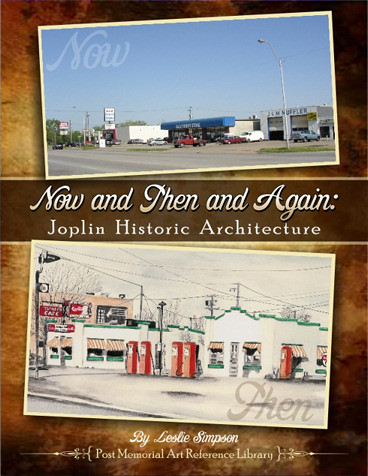Historic preservation in Joplin cannot be discussed without mentioning Leslie Simpson. The director of the Post Memorial Art Reference Library, Simpson is a long established expert of Joplin’s architecture and historic past. She is credited with initiating the push to preserve Joplin’s remaining historic buildings and homes. Simpson has played an instrumental role in the creation of the Joplin Historic Preservation Commission and Main Street Joplin. She has produced numerous slide shows on the city’s past and published a pamphlet titled, From Lincoln Logs to Lego Blocks: How Joplin Was Built. Such is her impact that the city proclaimed a day in her name and the Missouri General Assembly honored her achievements.
One of Ms. Simpson’s most well known works was a fascinating slide show presentation entitled, “Extreme Makeover: Joplin Edition,” that compared historic photographs of Joplin buildings and homes to present day photographs of the same locations. In December, 2009, she published her latest book, Now and Then and Again: Joplin Historic Architecture. Now and Then and Again is the published version of her popular lecture on Joplin’s architectural past.
Any fan of American architecture from the late 19th Century to the early 20th Century will both adore and loathe reading Ms. Simpson’s latest work. Readers will love it for the photographs of grand old buildings and majestic finely cut stone homes that once populated Joplin. It will, however, make the reader grimace at the lack of foresight and vision that cost Joplin some of its finest architectural masterpieces.
Now and Then and Again is written somewhat categorically, beginning with photographs of many of its former homes and buildings that represented the first several decades of the city’s prosperous growth. This may well be the most painful part for those who mourn the loss of Joplin’s finest buildings. as it reveals the devastation of the period of Urban Renewal. During the 1960s and 1970s, Urban Renewal oversaw the destruction of many of American’s turn of the century architecture under the belief that their replacements would spark economic growth and development. Sadly, such was not the case with Joplin. Downtown Joplin became a vast wasteland of empty parking lots and neglected store fronts.
Despite her passion for Joplin’s lost history, Ms. Simpson maintains a neutral tone, letting the devastation of Urban Renewal speak for itself. Buildings such as the Connor and Keystone hotels, the Worth Block, and other crown jewels of Joplin’s past were lost to the wrecking ball. By the time the reader finishes with this first part of the book, he or she can begin to dry their tears with the knowledge that some buildings survived, though are now hidden behind more modern facades. One example is the home of the Joplin Globe whose gaudy outdated facade belies the fact that it still has the bones of a century old brick building underneath.
Now and Then and Again opts for an ending on a happier note. The last two sections of the book are devoted to those structures still standing decades after their construction, and in a somewhat smaller part, those buildings which have recently been renovated. Now and Then and Again is not entirely made up photographs. Each photographic subject is accompanied with a paragraph or two of information which generally consists of the history of the building or house, the architectural style, and the individuals who owned them. Conveniently, Ms. Simpson provides two indexes, one by name and the other by address.
In the unfortunately limited pantheon of resources for those seeking to learn more about the history of Joplin, Ms. Simpson’s Now and Then and Again is a welcome addition. It serves as a wonderful reference for both the trained and untrained to a past built by stone, brick, and beam. Any collection is better for its inclusion, and knowledge of its contents most certainly help to bring alive the Joplin of the past, and to discover its wonder in the present.

The cover of Leslie Simpson's work, "Now and Then and Again: Joplin Historic Architecture."
For information about purchasing a copy of Ms. Simpson’s work, follow this link to the Post Memorial Art Reference Library website. Now and Then and Again consists of 95 pages, sells for $17.95 and is published by the Winfred L. and Elizabeth C. Post Foundation, Joplin, Missouri.

